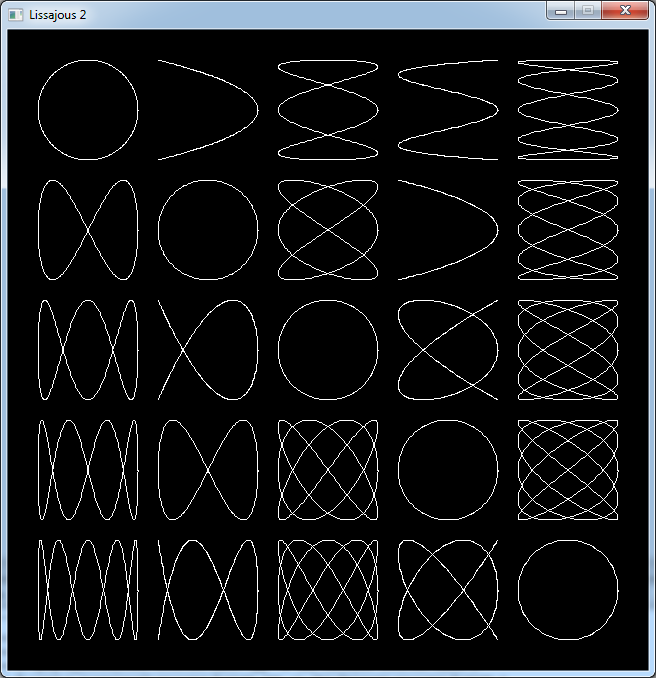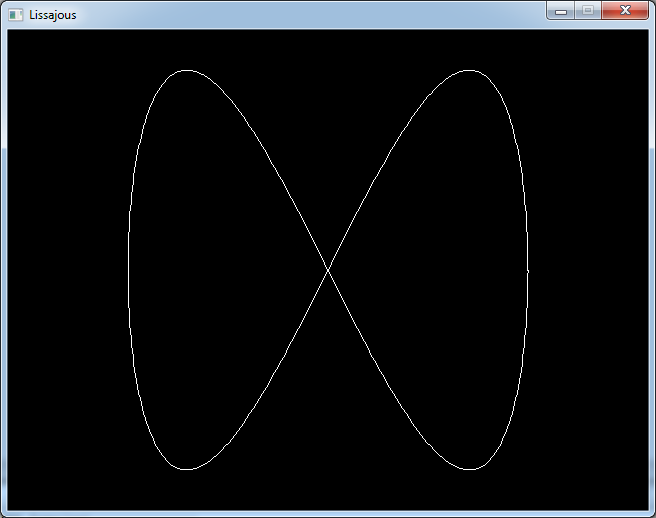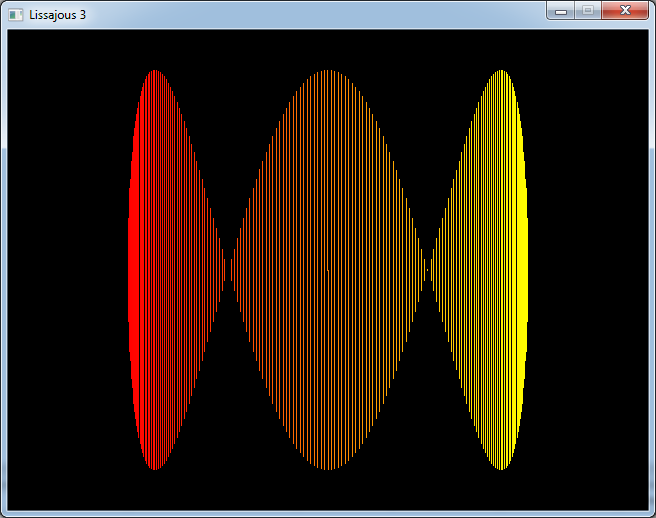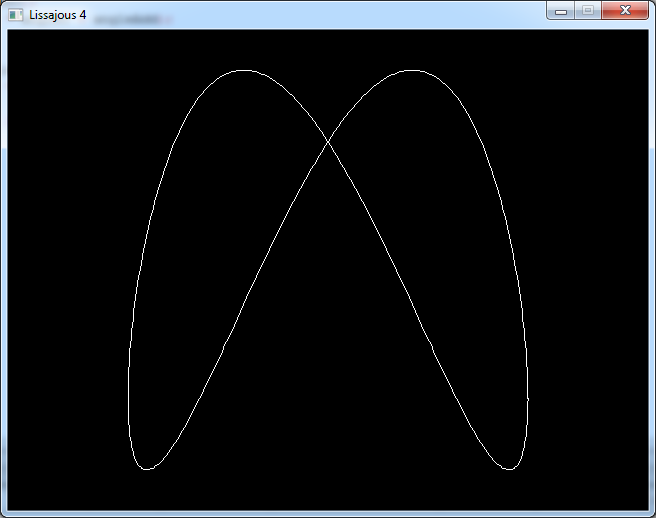The code in this article was written using Code::Blocks and SDL 2.
You can read
here a guide to install this sofware.
Although it is based on SDL, I don't use its functions directly. I have written a small library with a few basic
functions to ease the understanding and the portability to another language.
You can read more about this lib
here.
This article uses the line function we added in
the Bresenham's line algorithm.
Playing again with the circle
In a previous article we talked about the circle and found these equations
x = xC + R * cos θ
y = yC + R * sin θ
We tried to change the radii and to add a value to the angle θ and we got various ellipses.
But what happens if we multiply θ by a value ?
x = xC + R * cos(a1 * θ)
y = yC + R * sin(a2 * θ)
Let's try with a
1 = 1 and a
2 = 2;
int main(int argc, char* argv[])
{
// init the window
gfx.init("Lissajous", SCREEN_WIDTH, SCREEN_HEIGHT);
gfx.init2D();
gfx.clearScreen(Color(0, 0, 0, SDL_ALPHA_OPAQUE));
int centerX = SCREEN_WIDTH / 2;
int centerY = SCREEN_HEIGHT / 2;
int radius = 200;
for (int i = 0; i < 360; i++)
{
float angle0 = DEG_TO_RAD(i);
int x0 = centerX + radius * cos(angle0);
int y0 = centerY + radius * sin(2.0 * angle0);
float angle1 = DEG_TO_RAD(i + 1);
int x1 = centerX + radius * cos(angle1);
int y1 = centerY + radius * sin(2.0 * angle1);
gfx.line(x0, y0, x1, y1, Color(255, 255, 255));
gfx.render();
sys.wait(20);
}
// wait until we quit
while (sys.isQuitRequested() == false)
{
gfx.render();
sys.wait(20);
sys.processEvents();
}
gfx.quit();
return EXIT_SUCCESS;
}
Download source code
Download executable for Windows
We get a curve that looks like an infinity symbol.
If we vary a
1 and a
2 between 1 and 5 we get different shapes.
#define SCREEN_WIDTH 640
#define SCREEN_HEIGHT 640
int main(int argc, char* argv[])
{
// init the window
gfx.init("Lissajous 2", SCREEN_WIDTH, SCREEN_HEIGHT);
gfx.init2D();
gfx.clearScreen(Color(0, 0, 0, SDL_ALPHA_OPAQUE));
for (int i = 0; i < 360; i++)
{
for (int c2 = 1; c2 < 6; c2++)
for (int c1 = 1; c1 < 6; c1++)
{
int centerX = SCREEN_WIDTH / 2 + (c1 - 3) * 120;
int centerY = SCREEN_HEIGHT/ 2 + (c2 - 3) * 120;
int radius = 50;
float angle0 = DEG_TO_RAD(i);
int x0 = centerX + radius * cos(c1 * angle0);
int y0 = centerY + radius * sin(c2 * angle0);
float angle1 = DEG_TO_RAD(i + 1);
int x1 = centerX + radius * cos(c1 * angle1);
int y1 = centerY + radius * sin(c2 * angle1);
gfx.line(x0, y0, x1, y1, Color(255, 255, 255));
}
gfx.render();
sys.wait(20);
}
// wait until we quit
while (sys.isQuitRequested() == false)
{
gfx.render();
sys.wait(20);
sys.processEvents();
}
gfx.quit();
return EXIT_SUCCESS;
}
Download source code
Download executable for Windows

These shapes are called Lissajous curves.
Well in fact it is not the real definition of a Lissajous as it should use 2 sines:
x = xC + R * sin(a1 * θ)
y = yC + R * sin(a2 * θ)
But our definition gives the same kind of curves.
In electronics when you use an oscilloscope, you can plug in a sine current to deflect the spot horizontally and
another one to deflect it vertically.
If the currents have different frequencies you will then see this kind of curves.
This is a method used to measure the phase difference between the two currents.
This curve also represents the movement of a double-pendulum, where one pendulum moves along the x axis and the
other moves along the y axis.
Now we only used integers for a
1 and a
2.
You can also try with non integer values. You will then need to change the angle further than 360 degrees to get
the full curve.
But you will get the same kind of shapes because it's only the a
1 / a
2 that defines them.
As many of these curve are symmetrical with respect to the x axis, one way to get a filled shape is to draw
vertical lines from this axis.
int main(int argc, char* argv[])
{
// init the window
gfx.init("Lissajous 3", SCREEN_WIDTH, SCREEN_HEIGHT);
gfx.init2D();
gfx.clearScreen(Color(0, 0, 0, SDL_ALPHA_OPAQUE));
int centerX = SCREEN_WIDTH / 2;
int centerY = SCREEN_HEIGHT/ 2;
int radius = 200;
for (int i = 0; i < 360; i++)
{
float angle = DEG_TO_RAD(i);
int x = centerX + radius * cos(angle);
int y = centerY + radius * sin(3.0 * angle);
Color c;
c.r = 255;
c.g = 128 + 127 * cos(angle);
c.b = 0;
gfx.line(x, y, x, centerY, c);
gfx.render();
sys.wait(20);
}
// wait until we quit
while (sys.isQuitRequested() == false)
{
gfx.render();
sys.wait(20);
sys.processEvents();
}
gfx.quit();
return EXIT_SUCCESS;
}
Download source code
Download executable for Windows
Multiplication and addition
Now what happens if we add a value to the angle like we did in the last article ?
float angleAdd = DEG_TO_RAD(40);
for (int i = 0; i < 360; i++)
{
float angle0 = DEG_TO_RAD(i);
int x0 = centerX + radius * cos(angle0);
int y0 = centerY + radius * sin(2.0 * angle0 + angleAdd);
float angle1 = DEG_TO_RAD(i + 1);
int x1 = centerX + radius * cos(angle1);
int y1 = centerY + radius * sin(2.0 * angle1 + angleAdd);
gfx.line(x0, y0, x1, y1, Color(255, 255, 255));
gfx.render();
sys.wait(20);
}
Download source code
Download executable for Windows
We get a distorted curve




 Video of a double pendulum drawing Lissajous
Video of a double pendulum drawing Lissajous